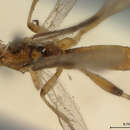Comprehensive Description
provided by Smithsonian Contributions to Zoology
Orgilus lateralis (Cresson)
Eubadizon lateralis Cresson, 1872a, p. 229.
Orgilus kearfotti Ashmead, 1903, p. 144.
Orgilus maculiventris (Cresson).—Cushman, 1920, p. 290.—Nickels, Pierce, and Pinkney, 1950, p. 12.—Muesebeck and Walkley, 1951, p. 111.
I have seen the holotypes of lateralis, kearfotti, and maculiventris, and I think there can be no doubt that kearfotti is the same as lateralis. However, the repeated identification of this species as maculiventris has been incorrect; the latter is a very different form. The true lateralis is most like walleyi, new species, from which it may be distinguished as shown in the description of the latter species.
FEMALE.—Length usually ranging from 3 to 4 mm. Head about as wide as thorax, in dorsal view nearly twice as wide as long; face about 1.15 times as wide as eye height, finely punctate and shiny; anterior tentorial pits on a line with level of lower eye margins; malar space 0.3 as long as eye height; cheeks minutely granulose and mat; temples largely smooth, strongly receding, at mideye point hardly half as wide as eyes; occipital carina complete; ocellocular line about twice as long as diameter of an ocellus; antennae normally 27- to 32-segmented, even the shortest flagellar segments slightly longer than broad, the apical segment with a very short terminal spicule.
Mesoscutum shiny, with very shallow punctures; notauli sharply impressed and very finely, sometimes indistinctly, punctate; propodeum more or less punctate or rugulose punctate medially and finely granulose to nearly smooth laterally; side of pronotum and the mesopleuron smooth and shiny, the mesopleural furrow sinuate and evenly, finely foveolate; metapleuron often faintly alutaceous. Hind coxa three-fourths as long as hind femur and very finely coriaceous on the outer side; hind femur about 3.7 times as long as wide; inner calcarium of hind tibia about half as long as metatarsus; tarsal claw with a well developed subbasal tooth. Radial cell about 1.3 times as long as stigma; second abscissa of radius not nearly on a line with intercubitus; stub of third abscissa of cubitus punctiform; nervulus postfurcal; hind wing usually nearly 4.5 times as long as wide; lower abscissa of basella much longer than nervellus and usually half as long as mediella.
Abdomen usually a little narrower than thorax; first tergite usually about 1.5 times as long as broad at apex, confluently punctate or very finely rugulose, the dorsal keels weak and very short; second tergite around 1.2 times as broad at base as long, confluently punctate or finely rugulose punctate, more weakly so laterally; third tergite similarly but more weakly sculptured; fourth and fifth tergites usually somewhat punctate; ovipositor sheath usually about as long as distance from tegulae to end of abdomen, but in some of the smallest specimens, particularly those from Coleophoridae, the ovipositor sheath may be significantly shorter, occasionally only very slightly longer than the abdomen.
Honey yellow or ferruginous, usually varied with black; in the darkest specimens the vertex and occiput are largely darkened, and also the dorsum of the thorax and the abdomen, but the abdomen has yellowish markings at least at the sides; palpi usually yellow; antennae yellowish beneath, at least basally, brown above and toward apices beneath; wings clear hyaline; tegulae and wing bases yellow; legs honey yellow or ferruginous, the apices of the hind femora, usually the hind tibiae except at bases, where they are yellowish white, and the tarsi, more or less darkened.
MALE.—Essentially like the female but usually a little more slender.
HOLOTYPES.—That of lateralis is in the Academy of Natural Sciences of Philadelphia; that of kearfotti is in the United States National Museum (USNM 6960).
DISTRIBUTION.—The holotype of lateralis is from Illinois, that of kearfotti from Caldwell, New Jersey. Other material examined indicates a range from New Brunswick, Quebec, and Ontario to Florida and the Gulf Coast, and from there west to California; it also includes specimens from the state of Nuevo Leon, Mexico. Hosts recorded on the labels of the specimens include Acrobasis caryae Grote, A. comptoniella Hulst, A. indiginella (Zeller), A. juglandis (LeBaron), Pulicalvaria thujaella (Kearfott), P. piceaella (Kearfott), Petrova albicapitana Busck, Coleophora sp. on Betula, C. caryaefoliella Clemens, C. ulmifoliella McDunnough, Coleotechnites mackiei (Keifer), Recurvaria juniperella Kearfott, Mompha sp., and Choristoneura fumiferana (Clemens). I am not completely satisfied that the present treatment applies to only one species, but thus far I have been unable to discover satisfactory bases for distinguishing different forms.
- bibliographic citation
- Muesebeck, Carl F. W. 1970. "The Nearctic species of Orgilus Haliday (Hymenoptera: Braconidae)." Smithsonian Contributions to Zoology. 1-104. https://doi.org/10.5479/si.00810282.30

